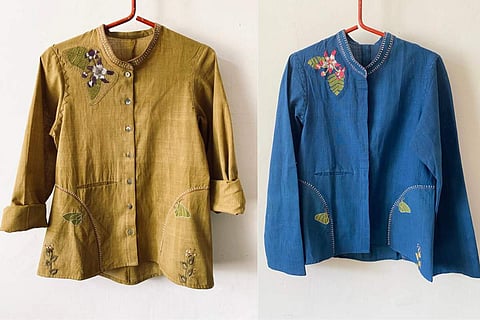
- LIFESTYLE
- FASHION
- FOOD
- ENTERTAINMENT
- EVENTS
- CULTURE
- VIDEOS
- WEB STORIES
- GALLERIES
- GADGETS
- CAR & BIKE
- SOCIETY
- TRAVEL
- NORTH EAST
- INDULGE CONNECT

Porgai, which also means “pride” in the Lambadi dialect founded by Gammi and Nalli, are a group of about 60 Lambadi women who belong to a Lambadi tribe. They have a rich tradition of hand embroidery, which their ancestors did on the clothing and other day-to-day articles. All of their artisans are farmers themselves, who take up craft during the dry summer and other seasons where there is no agricultural work available. Majority of Porgai’s products are made from organic cotton grown in their own villages, which is then hand-spun, hand-woven and dyed with natural dyes.
Their current biodiversity collection was created by the women of Lambadi artisans from Sittilingi Valley, Tamil Nadu, in collaboration with designer Anshu Arora and supported by Tarasha. These motifs are sewn on long wrap dress, a shirt dress/overlay, a basic shirt, a button-down blouse with panels, a basic well-fitting trouser and a tunic dress.
Anshu talks to Indulge about the collaboration.
Also read: Light up your look!
Is this your first collaboration? What made you take it up?
I am the founder of two labels (A Small Shop, New Delhi (1999-2006) and Jasonanshu/Small Shop, Bengaluru (2006-present), in partnership with Jason Cheriyan. Over the years, my practice has become more multidisciplinary. My primary focus has become working collaboratively with artisan groups.
I first visited Porgai post Covid, and over the years, I have come to feel like a member of the Porgai family. For years, these artisans have been producers for design labels, which is a reversal, where they own the brand and the designer provides pattern making skills, placement design, and storytelling. This way, they are invested and empowered to take their business forward. The design and sampling was funded by Tarasha and facilitated by Creative Dignity.
What are the unique features of Lambadi tribe embroidery?
Lambadi embroidery has a vast stitch vocabulary — bhuria, vegaro, pote, and suryakanti are some that come to my mind but there are up to 40 stitches and more. Along with the skill, the artisans have an amazing instinct around colour and composition. Traditionally, Lambadi embroidery is executed deftly without prior drawing, the motives that emerge are an aesthetic composite of lines, squares and circles. Mica mirrors were embedded into the embroidery. The embroidery is done on square and rectangular patches, which magically come together as the kanchli (blouse) and the phetiya (skirt). All of these are further decorated with coins, cowry shells and thread Chungas.
The Lambadi embroidery is close to sister Banjara communities spread across the Deccan region, Gujarat and Rajasthan. It is said that they may be a part of the Roma gypsy trail.
Also read: Luxe edit: Shimmer & shine
What are the contemporary twists that feature in this collaboration?
The idea for the embroidery motifs came from Dr Lalitha. When we got together for a workshop to ideate, the valley was flowering and full of butterflies, so she felt it would be a good idea to represent the valley’s biodiversity. During the workshop, we observed the same and drew out the motives, and decided on colours based on the species.
Although this was not a conscious attempt at a contemporary approach, I feel, together with the silhouettes, the collection slips easily into a contemporary urban lifestyle. The uniqueness of using embroidery as a tool for expressing the biodiversity of a region by the people who inhabit it strengthens their identity as a brand. The base fabric used for this collection is natural dye organic cotton woven and dyed at Gandhigram, but the cotton is grown in Sittilingi itself.
Price starts at Rs 4,500.
At Amethyst, R A Puram.
— manuvipin@newindianexpress.com